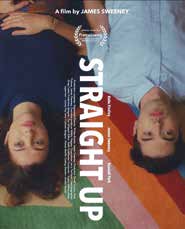Out queer writer/director James Sweeney’s Straight Up, opening March 20 in the Bay Area, is a terrific romcom with a twist. Todd (Sweeney) drops a bombshell on his friends Ryder (James Scully) and Meg (Dana Drori) when he tells them, “I think I’m not gay.”
This nervous, hyper-verbose, OCD guy soon meets Rory (Katie Findlay), a budding actress who shares his hyper-verbosity, his love of Gilmore Girls, and his desire not to have sex. (Among Todd’s many issues are his anxieties about bodily fluids.) They couple up in comfortable domesticity—Todd’s job is house-sitting in fabulous abodes—and figure out how to manage a relationship that almost everyone around them questions.
Straight Up wrings knowing laughs from gay stereotypes and pop culture references (there’s a fun running joke about Paul Newman). But Sweeney also infuses his film with poignant moments as well as perceptive insights about love and relationships. In addition, the filmmaker employs inventive visuals that frame the characters to comment on the action and their emotions.
In a recent phone interview with me for the San Francisco Bay Times, Sweeney spoke about his stylish and amusing new film.
Gary M. Kramer: How did you come up with this plot that is ironic for cleverly adhering to the very genre it subverts—that of the gay man/straight woman relationship?
James Sweeney: I imagined the film to be an homage and deconstruction of the romantic comedy genre and screwball comedies as well. It came from a place of wanting to put two lonely characters together who find safety in one another and tell it in a lighthearted, zippy way. I love the romcom genre. There are films that have dealt with similar themes, like The Wedding Banquet, Kissing Jessica Stein, and The Object of My Affection, but exploring it through a different lens.
Gary M. Kramer: How did you conceive of the characters of Todd and Rory? What qualities did you give them that made them meld so well?
James Sweeney: They are complementary. I imagine them as my inner dialogue, and they represent two different parts of my personality. I thought: What’s the other side of the argument? And then, similar interests—Bananagrams and Gilmore Girls, etc. I didn’t know Katie [Findlay] prior to casting her. The script was already written. She is smart and challenged me to elevate the material. She fleshed it out and made it better.
Gary M. Kramer: You cleverly frame the characters, showing Todd and Rory in separate shots while having a discussion or argument in bed together, and employing split screens or crosscutting between a pair of kissing scenes. Can you talk about how you approached the film visually?
James Sweeney: I’m familiar with the old screwball comedies, but I don’t watch them obsessively. We wanted things to feel real, if stylized and elevated, but not feel like they were stock or quirky characters. A lot of the story involves bifurcated vignettes. It is a dual protagonist story and the foundation of that is mutual respect. I wanted to give Todd and Rory equal weight in how we cover them visually. His style is static and minimalist, and she’s more chaotic and handheld. Together they blend, and we introduce movement. When you find yourself consumed in someone else’s world, their styles complement and fill one another.
 Gary M. Kramer: Can you talk about the different styles of humor in the film? There is irony, induced anxiety, visual gags, wordplay, and more.
Gary M. Kramer: Can you talk about the different styles of humor in the film? There is irony, induced anxiety, visual gags, wordplay, and more.
James Sweeney: Partially it’s a byproduct of having sat with the script for so long that once the joke is not funny, we need to add more to it. I want there to be enough story and character for people who don’t find something funny to have something to latch onto. I don’t consider myself to be a comedy writer, so I may be harsh about what I find funny, but I don’t limit myself to one type of humor.
Gary M. Kramer: What points are you making about how we play roles with our sexuality, or “act” ourselves?
James Sweeney: The log line for the films is, “A gay twentysomething finds his intellectual soulmate in a twentysomething actress.” But that’s reductive, and sexuality is a spectrum and where he starts is completely different than where he ends up. He assumes he’s gay because of his social conditioning—mannerisms or interests. People coded me as gay before I knew I was gay myself. I’ve talked with gay men who are attractive to women, but they don’t say that for fear of being ostracized in the gay community. “Gay” is a political word, but it can also be restricting. The film takes place is in a post-heterosexist word, but that’s not a world we live in.
Gary M. Kramer: The dramatic tension in the film is based on the possibility that Todd and Rory will couple up. Do you want viewers to root for them to be together?
James Sweeney: I always hope that viewers will simultaneously root for them to be together and that they find other people.
© 2020 Gary M. Kramer
Gary M. Kramer is the author of “Independent Queer Cinema: Reviews and Interviews,” and the co-editor of “Directory of World Cinema: Argentina.” Follow him on Twitter @garymkramer
Published on March 11, 2020
Recent Comments